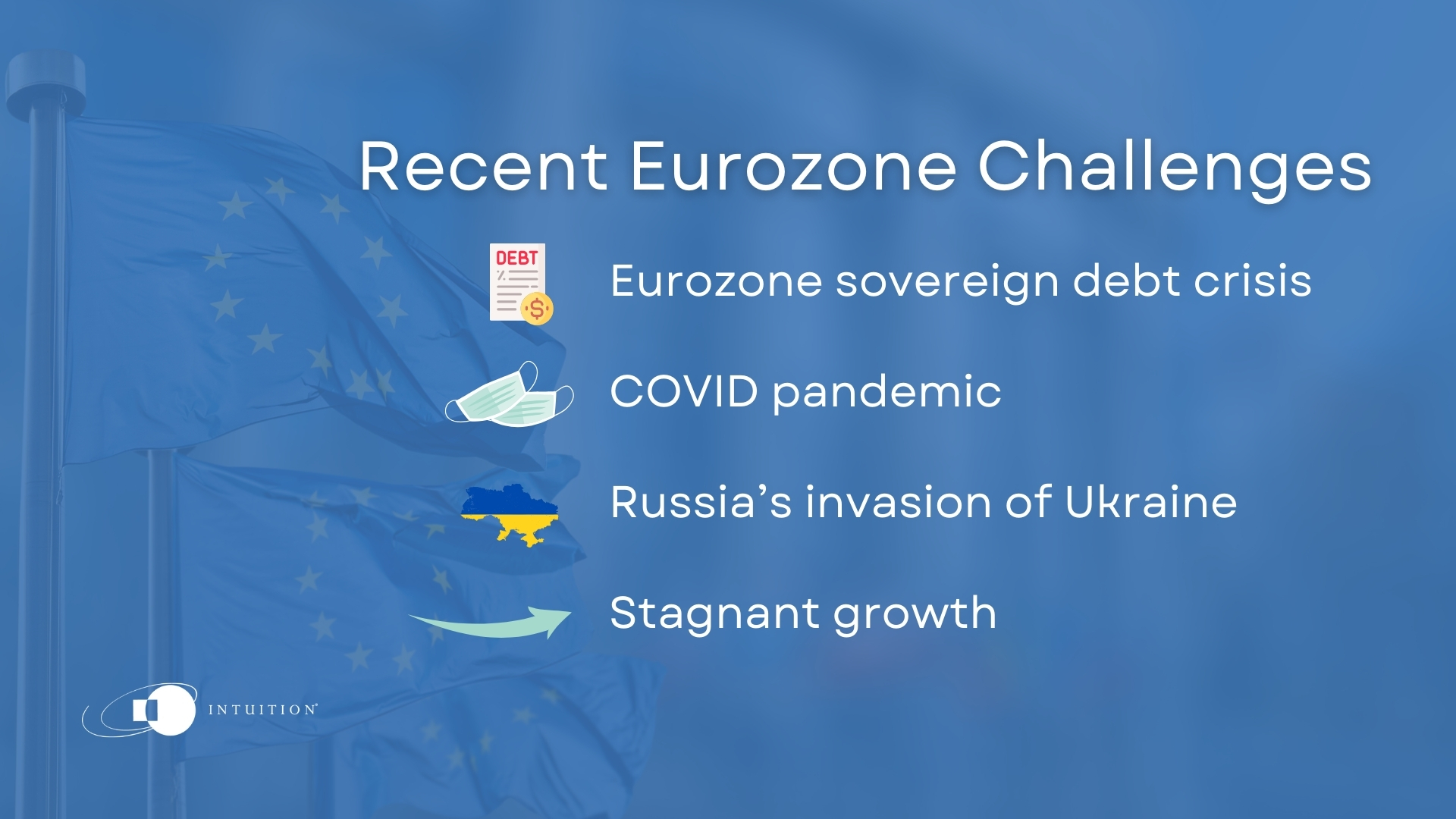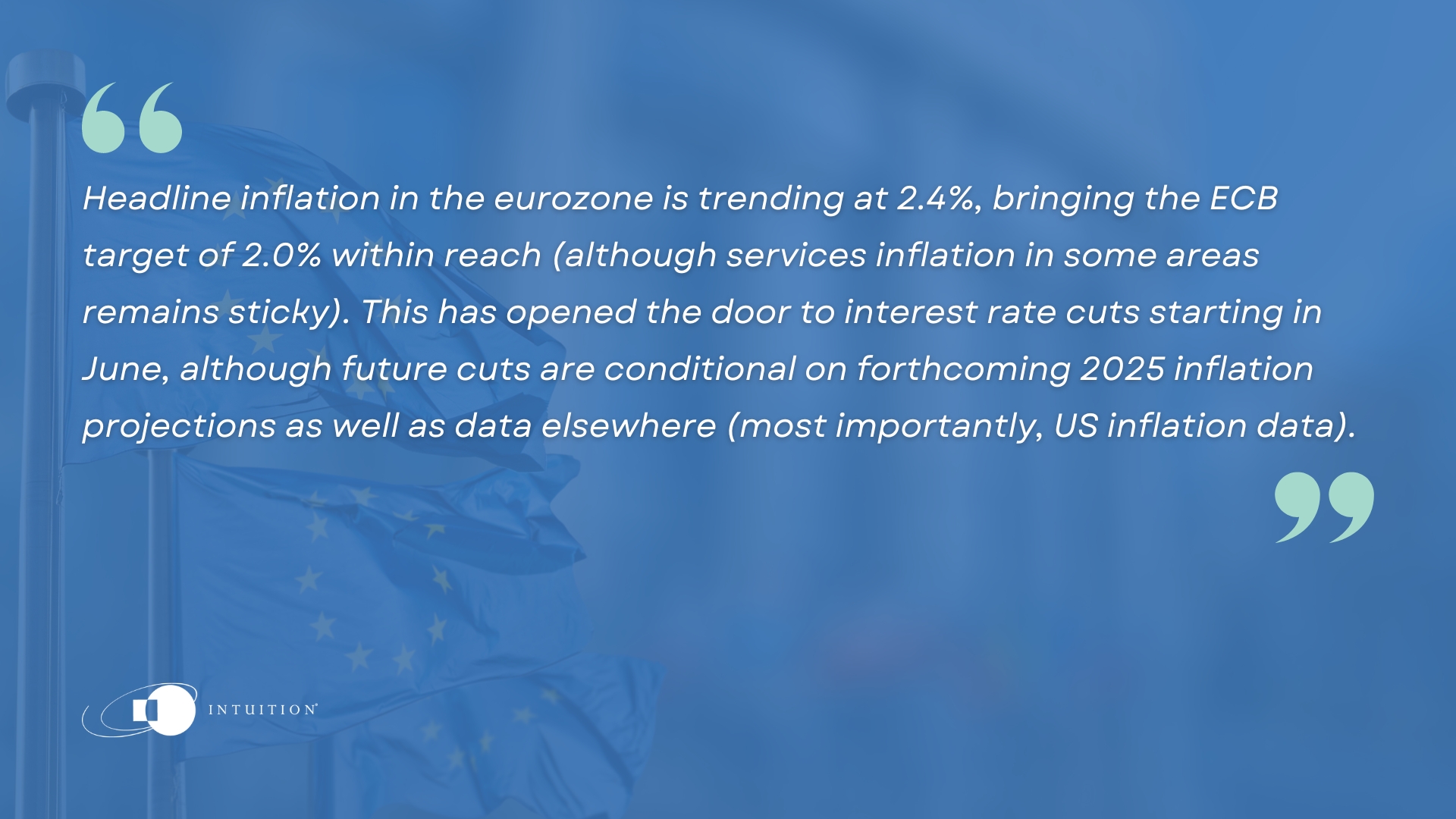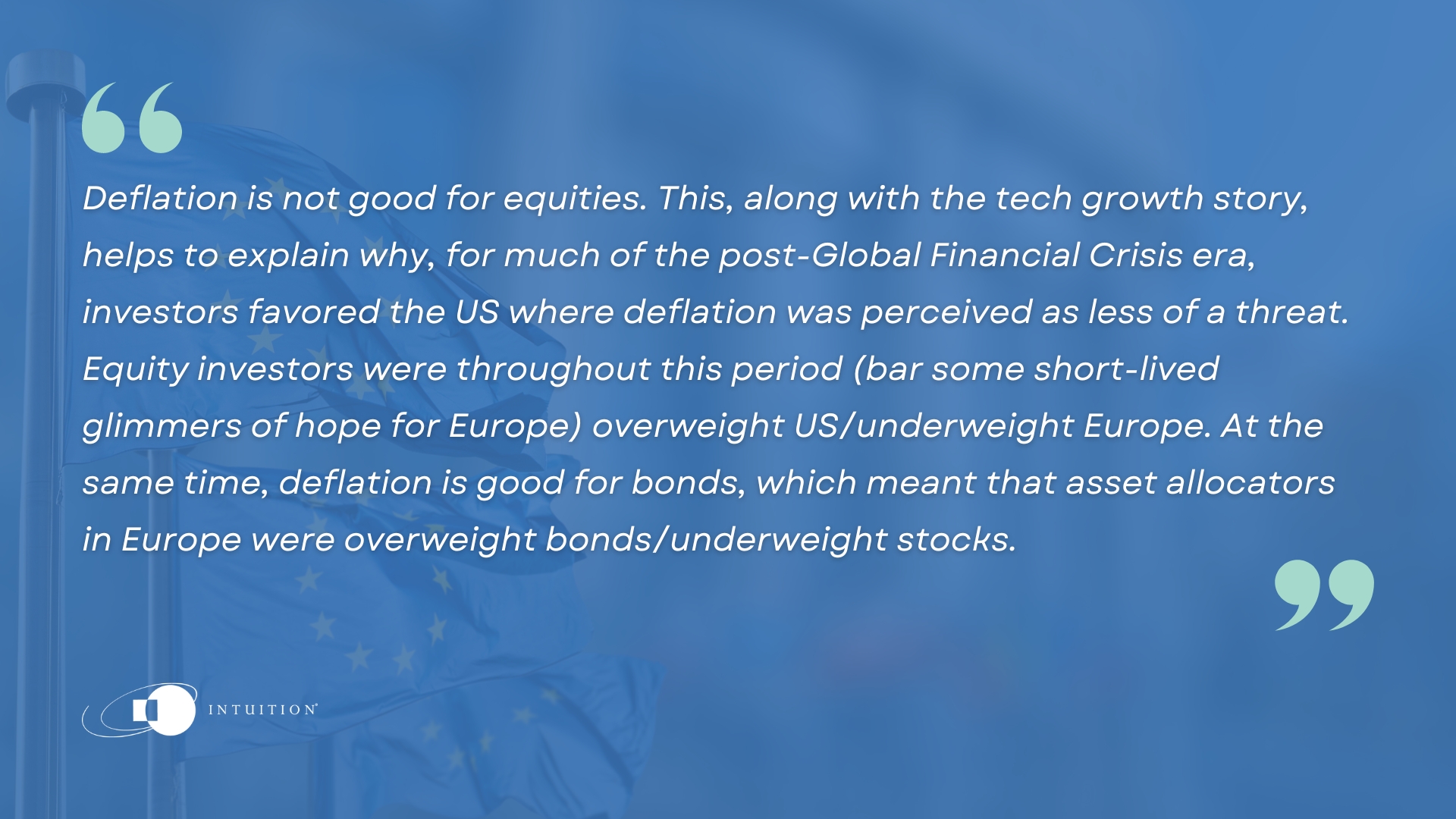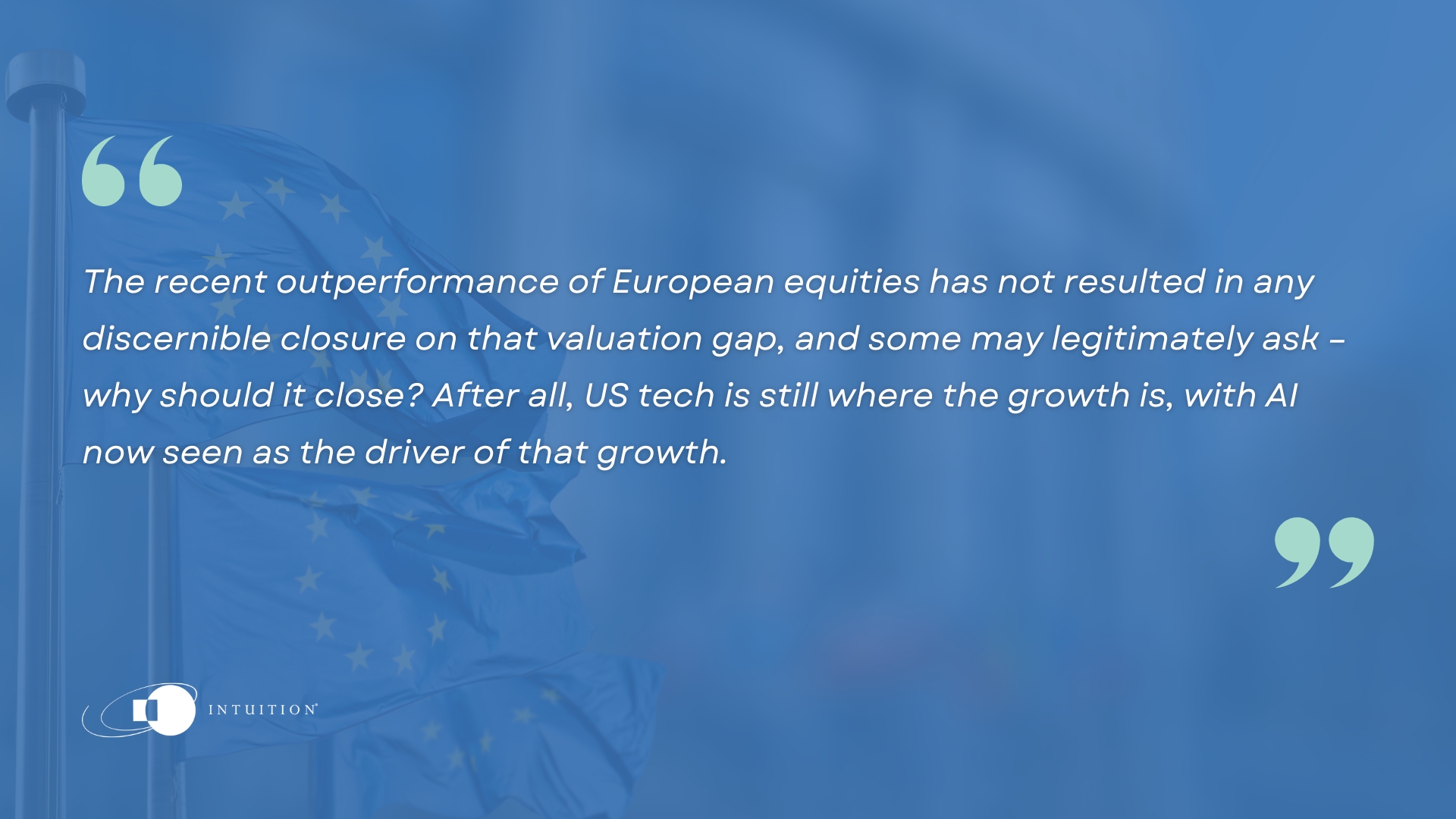European equities back in vogue
Beset by multiple crises and lackluster growth for over a decade, European equity market underperformance had become ingrained in investor expectations. However, since bottoming out in October 2022, they have been a surprise outperformer. Can this last?
For the best part of 15 years, a litany of challenges – from the Eurozone sovereign debt crisis to the COVID pandemic to Russia’s invasion of Ukraine to stagnant growth – has plagued Europe. It comes as no great shock therefore that investors shunned the continent’s equity markets for much of this period, leading to notable underperformance – at least relative to the US.
However, since bottoming out in October 2022 on peak inflation concerns and geopolitical tensions, European shares have experienced a revival that has confounded many investors. So far in 2024, European equities have sustained the rally, outperforming other regions (including the US), culminating in a succession of new all-time highs for many of its national bourses.
This strong performance can be attributed to several factors.

Positive macro & earnings surprises
Both inflation and growth figures for Europe have surprised to the upside so far this year.
Headline inflation in the eurozone is trending at 2.4%, bringing the ECB target of 2.0% within reach (although services inflation in some areas remains sticky). This has opened the door to interest rate cuts starting in June, although future cuts are conditional on forthcoming 2025 inflation projections as well as data elsewhere (most importantly, US inflation data).
GDP growth across the eurozone has also been beating expectations, with Q1 2024 coming in at 0.33% year-on-year versus a consensus estimate of 0.10%. Germany, having seen negative GDP growth of 0.50% in Q4 2023, came in at a positive 0.21% (versus a consensus of 0.1%). Elsewhere in the eurozone, Spain saw the strongest growth at 2.2%, while emerging Europe (notably Poland) has been posting figures well above this.
Some of this strength can be put down to pent-up demand from COVID-related stimulus measures. Another key driver has been the strong performance of the US economy, where the latest data showed robust expansion of 3.7% in the first quarter of 2024, surpassing expectations. It’s important to note that over half of the revenues of Europe’s listed equities are generated outside of Europe, and around 25% in the US. US economic strength is therefore a major tailwind for European equities, especially its exporters.
The positive economic data have contributed to stronger-than-expected corporate earnings growth in Europe for much of the period since those October 2022 lows. This in turn has led to upward revisions to earnings forecasts, which some analysts believe could be in the early stages of a revision cycle.
[Basel III, Basel IV, Basel III Endgame, & Basel 3.1: Terminology Explained]

Sentiment and positioning
The data may not be spectacular – German GDP growth, for example, is still barely in positive territory, while earnings have seen some bad quarters (for example, the second quarter of 2023). However, this all needs to be considered in the context of sentiment and positioning in European equities.
Thanks to the litany of challenges and stagnation in Europe over the past 15 years or so, deflation had, for a long time, been the primary concern for investors – long enough for expectations of European equity underperformance to become ingrained in the investor psyche.
Deflation is not good for equities. This, along with the tech growth story, helps to explain why, for much of the post-Global Financial Crisis era, investors favored the US where deflation was perceived as less of a threat. Equity investors were throughout this period (bar some short-lived glimmers of hope for Europe) overweight US/underweight Europe. At the same time, deflation is good for bonds, which meant that asset allocators in Europe were overweight bonds/underweight stocks.
When market positioning is heavily offside, it doesn’t take much to trigger a turnaround. The ensuing rallies can be powerful, as investors are compelled to unwind their positions, through forced buying of equities by long-only funds that are underweight, short-covering by hedge funds, and asset allocation switches out of bonds into equities.
It looks like this is what has played out in Europe. The inflation that emerged in late 2021 forced a major rethink, with bonds taking a big hit. However, funds underweight/short European equities were effectively “saved” by Russia’s invasion of Ukraine and aggressive monetary tightening that drove equities down sharply. Eventually, European markets absorbed these shocks, and with the benefit of hindsight, sentiment in Europe was clearly too gloomy and equities had become too cheap.

What can sustain the rally?
Now that this positioning unwind may have run its course (or be close to doing so), investors need to ask what can sustain the rally from here. Europe is no longer under the radar, or in a “stealth bull market”. This leaves it vulnerable to setbacks. However, there are still factors in Europe’s favor.
European valuations still not stretched
A key variable is valuation. The MSCI Europe forward price/earnings ratio stands at 13.5x. This is not especially cheap; nor is it demanding. Europe still trades at a steep discount to the US, which trades at a forward price/earnings ratio close to 20x.
European equities have traditionally traded at a discount to their US counterparts, reflecting factors such as perceived differences in growth prospects, profitability, sector composition, and the absence of a retail investor culture in Europe. Following the financial crisis of 2008, this valuation gap widened significantly, powered by the compelling secular growth story of the US technology sector.
The recent outperformance of European equities has not resulted in any discernible closure on that valuation gap, and some may legitimately ask – why should it close? After all, US tech is still where the growth is, with AI now seen as the driver of that growth.

Less expected of Europe vs. US
While sentiment and positioning on Europe may have shifted a long way from doom and gloom territory, investors are hardly euphoric. The consensus forecasts earnings growth of 5% for MSCI Europe in 2024, versus double digits or higher in the US in 2024 and beyond.
The bar for earnings beats – that would force further upward revisions to estimates – is therefore notably lower in Europe than in the US. It’s possible that those loftier expectations for the US are not met. Some analysts have cautioned that the AI “wars” could cannibalize areas of big tech (such as the Cloud), while the significant capital outlays required may cause problems for a sector known for its asset-light model. Many experts have also argued that AI may ultimately benefit non-tech sectors such as industrials and utilities more than tech. This would swing Europe’s sector composition disadvantage to an advantage.
When investors become accustomed to long-established trends, markets can spring surprises. It might surprise casual observers to learn that, in the post-COVID era, European banks (perhaps the most unloved European sector) have comfortably outperformed broader US tech. While finance professionals may have caught onto this by now, few would have predicted it back in 2020/2021.
Intuition Know-How has a number of tutorials relevant to the content of this article:
- Equity Markets – An Introduction
- European Equity Markets
- Equity Indices
- Equity Valuation – An Introduction
- Equity Valuation – DCF Models
- Equity Valuation – Other Methods
- Economic Indicators – An Introduction
- GDP Indicators
- Inflation Indicators


